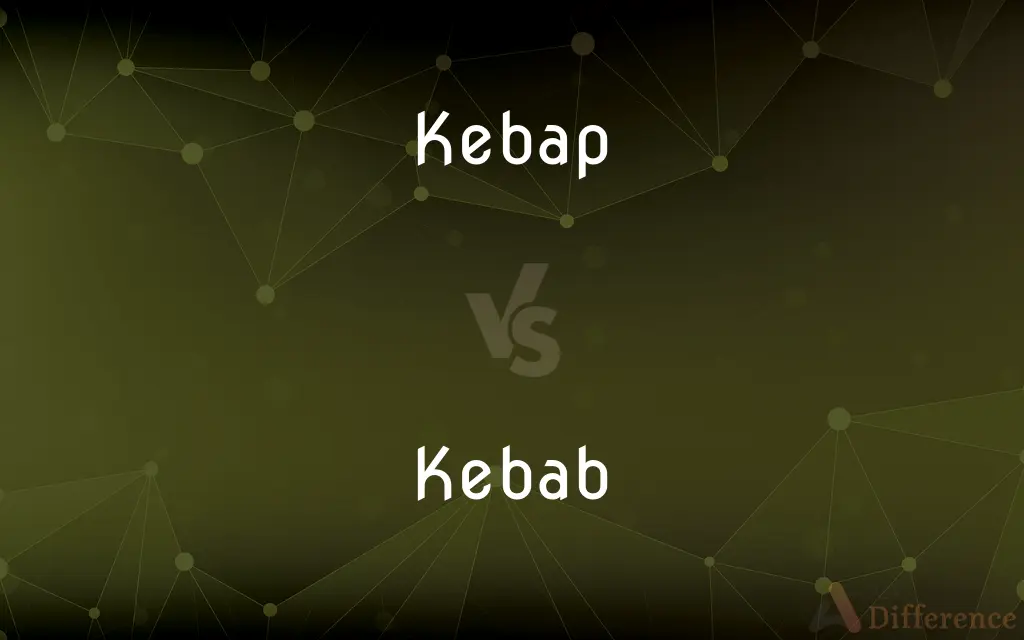Kebap vs. Kebab — What's the Difference?
By Urooj Arif & Maham Liaqat — Updated on May 8, 2024
Kebap refers to the Turkish-style grilled or skewered meat often associated with Döner kebap. Kebab encompasses a broader range of Middle Eastern grilled or skewered meats, like shish kebabs, offering diverse regional varieties.

Difference Between Kebap and Kebab
Table of Contents
ADVERTISEMENT
Key Differences
Kebap is rooted in Turkish cuisine and typically includes dishes like Döner kebap, where seasoned meat is grilled on a vertical rotisserie. Kebab, on the other hand, is a general term used more broadly across Middle Eastern and South Asian cuisines, often referring to dishes like shish kebabs, which are skewered meats grilled over an open flame.
Kebap often emphasizes lamb and beef cooked with distinct Turkish flavors, usually served with rice, vegetables, or flatbread. Kebab incorporates a wider variety of meats, including lamb, beef, chicken, and seafood, often accompanied by regional sides or sauces.
Kebap can include various regional dishes like Iskender kebap, characterized by sliced lamb served on pita bread and drenched in tomato sauce. Kebab, however, includes more diversity, with variations like seekh kebabs (ground meat skewers), kofta (meatballs), and satays.
Kebap is frequently served in Turkish restaurants and has gained popularity globally due to its distinct preparation styles. Kebab, on the other hand, is found in many international cuisines, from Greek souvlaki to Indian tandoori kebabs.
Comparison Chart
Origin
Turkey
Middle East, South Asia
ADVERTISEMENT
Cooking Method
Often grilled, vertical rotisserie
Grilled, skewered, or tandoor-cooked
Meat Types
Lamb, beef
Lamb, beef, chicken, seafood, more
Popular Varieties
Döner, Iskender, Adana kebap
Shish, seekh, kofta, tandoori
Accompaniments
Rice, vegetables, pita
Regional sides, sauces, flatbreads
Compare with Definitions
Kebap
Dish featuring marinated meat cooked on skewers.
The chef prepared succulent Adana kebap.
Kebab
Often served with flatbread or rice.
The kebab was wrapped in warm naan bread.
Kebap
Specific to Turkish culinary traditions.
The kebap platter included Iskender kebap.
Kebab
Middle Eastern or South Asian dish with grilled or skewered meat.
The chicken kebabs were marinated in yogurt and spices.
Kebap
Cooked on a vertical rotisserie, typical for döner.
The chef shaved slices of beef from the kebap rotisserie.
Kebab
Popular street food across many cultures.
I bought a lamb kebab from a local food vendor.
Kebap
Served with accompaniments like rice or pita bread.
I enjoyed the kebap with fragrant rice and grilled vegetables.
Kebab
Cooked on skewers or directly over a grill.
The chef threaded the meat on skewers for shish kebabs.
Kebap
Turkish style of grilled or rotisserie meat.
I ordered a lamb döner kebap wrapped in pita.
Kebab
Can refer to a variety of regional grilled meat dishes.
Tandoori kebabs have a distinct smoky flavor.
Kebap
Alternative spelling of kebab
Kebab
Kebabs are various cooked meat dishes with their origins in Middle Eastern cuisine. Numerous variants are popular around the world.
Kebab
A dish of pieces of meat, fish, or vegetables roasted or grilled on a skewer or spit.
Kebab
Shish kebab.
Kebab
(British) A dish of pieces of meat, fish, or vegetables roasted on a skewer or spit, especially a doner kebab.
Kebab
(AU) A hand-held dish consisting of pieces of meat roasted on an upright skewer mixed with fresh vegetables and sauces and rolled up in a round piece of unleavened bread.
Kebab
(US) A shish kebab or any other food on a skewer.
Kebab
A restaurant that sells kebabs
Let's go to the kebab after the club.
Kebab
(chemistry) The outward growing portions of a shish kebab structure.
Kebab
A Muslim, usually of southern European, Middle Eastern, or North African descent.
Kebab
The vulva.
Kebab
(GUI) menu icon of three vertical dots
Kebab
(transitive) To roast in the style of a kebab
Kebab
To stab or skewer
Kebab
See kabab and kabob.
Kebab
Cubes of meat marinated and cooked on a skewer usually with vegetables
Common Curiosities
Is kebap unique to Turkey?
Yes, kebap typically refers to Turkish dishes like döner and Iskender.
How does kebab differ globally?
Kebab has many regional variants, like Indian seekh and Greek souvlaki.
What distinguishes kebap from kebab?
Kebap specifically refers to Turkish cuisine, while kebab is broader, covering Middle Eastern and South Asian dishes.
Can kebap be made with chicken?
Yes, some kebap dishes use chicken instead of traditional lamb or beef.
What is the cooking method for kebab?
Kebab is usually grilled, either on skewers or directly over a fire.
Is kebab spicy?
It depends on the region, but kebabs can range from mild to very spicy.
Is kebap a full meal?
Yes, kebap is often served with rice, vegetables, or pita to make a full meal.
Are kebap and shawarma similar?
Yes, both are cooked on a rotisserie, but shawarma is seasoned differently and often includes different toppings.
Can kebab include vegetables?
Yes, kebabs can include vegetables like peppers or onions on skewers.
Does kebap always use skewers?
Not always, as döner kebap uses a vertical rotisserie.
Which kebab is the most popular worldwide?
Döner kebab is highly popular in many countries as a street food.
How long has kebab been around?
Kebab has historical roots dating back centuries in Middle Eastern cuisine.
Is there a vegetarian kebab option?
Yes, vegetarian kebabs can include vegetables or plant-based proteins.
What is a tandoori kebab?
It's a kebab cooked in a tandoor, a traditional Indian clay oven.
Can kebap be eaten cold?
While it's best enjoyed hot, some varieties can be consumed cold, particularly leftovers.
Share Your Discovery

Previous Comparison
Individuals vs. Individual
Next Comparison
Overturn vs. RepealAuthor Spotlight
Written by
Urooj ArifUrooj is a skilled content writer at Ask Difference, known for her exceptional ability to simplify complex topics into engaging and informative content. With a passion for research and a flair for clear, concise writing, she consistently delivers articles that resonate with our diverse audience.
Co-written by
Maham Liaqat















































